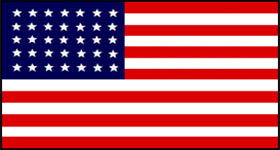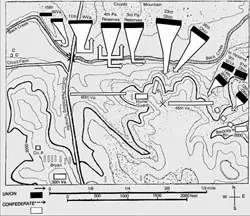Union Forces Commanded by: Brig. Gen. George Crook
Confederate Forces Commanded by: Brig. Gen. Albert Jenkins
**Missing and Captured Conclusion: Union Victory |  |
BATTLE SUMMARY
Gen. Ulysses S. Grant, when planning his offensive of 1864, wanted to put as much pressure on the Confederates as possible, and in as many places as possible. Gen. George G. Meade's Army of the Potomac would strike Gen. Robert E. Lee while Maj. Gen. Benjamin Butler advanced on Richmond, and Maj. Gen. William T. Sherman advanced on Atlanta while Banks made a foray up the Red River. In Virginia, Maj. Gen. Franz Sigel, with 6,000 men, would advance up the Shenandoah Valley to Staunton and take Lynchburg if possible. A small diversion would be made at Lewisburg. Brig. Gen. William Averell with 2,000 men, mostly cavalry, would raid Saltville in the southwest, 1 of only 2 salt producers in the Confederacy, and move east, raiding the Virginia and Tennessee Railroad and the lead mines near Wytheville. He would link up with his superior, Brig. Gen. George Crook with 6,000 men, who would raid the railroad bridge over the New River at Central Depot, now Radford. Combined, Crook and Averell would then move to Lynchburg and link up with Sigel. Operations this complex rarely work out according to plan, and this raid would be no exception.
On May 9, Crook's 3 brigades, 6,100 men, on a raid into southwestern Virginia encountered a patchwork Confederate force under Brig. Gen. Albert Jenkins at Cloyd's Mountain. Fighting was furious and hand-to-hand. Casualties were heavy for the size of the forces engaged. The Confederate reaction to the Union offensive was confused. Lee ordered Gen. Breckinridge, the commander in southwest Virginia, to move 4,000 men from southwest Virginia to meet Sigel in the Shenandoah Valley. Breckinridge would defeat Sigel at New Market on the 15th, but the defenses of southwest Virginia had been severely weakened. Jenkins was left in command of southwest Virginia with just 4,600 troops. McCausland's Confederate brigade had been in a good position to block Crook as he advanced on Princeton, West Virginia, but McCausland was ordered to Dublin to entrain for the Shenandoah. Reaching Dublin late on the 6th, McCausland began to entrain, but was then ordered off the train to remain in Dublin, where he camped that night.
 Click Map to Enlarge Map |
Ringgold's battery was shanghaied from rail travel and sent north to confront Crook. The Home Guard of Christiansburg was called out, and these men and all other available troops were also sent north from Dublin to stop the enemy. Locals, including the Home Guards, believed that the gap through Cloyd's Mountain was the ideal place to block Crook. The gap, at 2,400 feet of elevation, towered 500 feet over the land to its north, where Little Walker Creek cut through Walker Mountain, another defensible choke point.
But the Ringgold artillery was first to arrive on the scene and instead deployed on the left side of the Dublin-Pearisburg Turnpike, along a ridge south of the mountain with good fields of fire for the guns. McCausland, then Jenkins, approved the position but placed skirmishers at the gap. By the morning of the 9th, Jenkins had 2,400 men and 10 pieces of artillery in position. Crook was rushing south to meet him with 6,500 men and 12 pieces of artillery.
Crook flanked the skirmishers that had been placed on Cloyds Mountain, and could then see the imposing Confederate position down below. Crook wisely decided the best course of action would be to flank the Confederates on their right, so he ordered Col. White's 2nd Brigade to follow the lead of a local black guide. The 3rd Brigade would be on the Union right, near where the road emerges from the woods in the picture, and the 1st Brigade would be in the center, off the picture to the right. White positioned his 2nd Brigade on the Confederate right flank and waited for the signal to attack which was to be 3 artillery shots.
Crook, however, had ordered his artillery to move down the mountain and deploy in the field near the 3rd Brigade. This would distract attention for the coming infantry attack, but predictably, the Confederates won the artillery duel.
In this minor, though extremely vicious engagement, the Union victory enabled Crook to burn New River Bridge, a major objective of the raid. But Crook, learning of Grant's repulse at the battle of Wilderness, abandoned the raid on the 11th.
